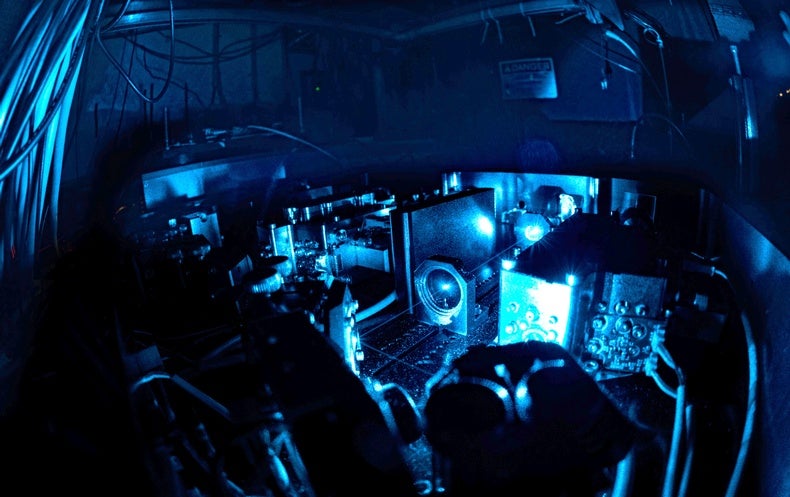
One of the universe’s oldest mysteries is also one of its most puzzling. During the big bang, some 13.8 billion years ago, both matter and antimatter—which are thought to be identical, save for the former having the opposite electrical charge of the latter—should have been created in equal amounts. When these two come into contact with each other in today’s universe, they are annihilated in a burst of light and more exotic fundamental particles. Why, then, do we live in a matter-dominated cosmos rather than a howling void filled only with ephemeral echoes of an all-consuming annihilation from the dawn of time?
To find out, particle physicists have been busy testing the properties of both matter and antimatter to see how they compare. For matter, this process is relatively straightforward. But for antimatter, it is exceedingly more challenging. Given that antimatter is instantly destroyed upon interacting with matter, keeping it intact for detailed investigation is difficult. For the past decade, however, experimentalists have made great strides in such studies by isolating ever greater quantities of antimatter in a vacuum for longer and longer periods, progressively enabling new research breakthroughs.
The latest findings come from scientists at the ALPHA experiment at CERN near Geneva, who report in the journal Nature that they were able to suspend atoms of the antimatter equivalent of hydrogen, antihydrogen, for hundreds of hours in a vacuum. Doing so allowed them to observe that in antihydrogen—which is composed of an antiproton and a positron, the electron’s antiparticle—jumps in energy levels known as the Lamb shift were identical to those seen in hydrogen. This symmetry rules out one of the possible answers to the matter-antimatter discrepancy.
“We’ve had other measurements that we’ve made in the past, but this one is fundamentally different. We’re studying the spectrum of antihydrogen,” says study co-author Jeffrey Hangst of Aarhus University in Denmark. “There’s no unexpected results, but the fact that we’re able to look at these things now in antimatter is really significant for us and for the future of what we do. When we’re looking for complete agreement between the physics of matter and antimatter, we have to check all of the boxes, and this is a very important one.”
The Lamb shift was first observed by American physicist Willis E. Lamb, Jr., in 1947—a measurement that would later win him a Nobel Prize. Electrons orbit the nuclei of atoms, but they can undergo quantum jumps between orbits, corresponding to certain energy levels, which result in an emission or absorption of light. Lamb showed that two energy levels of hydrogen, 2S and 2P, exhibited a detectable change, or shift, that defied some theoretical predictions. Attributed to the existence of virtual particles being emitted and reabsorbed in a vacuum, the Lamb shift’s discovery contributed to myriad major developments in quantum theory. “The result of the paper by the ALPHA collaboration is that the Lamb shifts of hydrogen and antihydrogen seem to be identical,” says Stefan Ulmer of CERN, who was not involved in the latest research.
Matter and antimatter’s behavioral symmetry is also governed by something known as charge-parity-time (CPT) symmetry, which essentially states that all laws of physics in the universe remain the same under any transformations (outside of a few well-defined special cases). To explain the matter-antimatter problem, something in CPT theory—and thus in the Standard Model of physics, the framework of all known subatomic particles and fundamental forces except gravity—must be wrong. By observing the Lamb shift in both matter and antimatter, physicists hope to narrow down what that “something” might be.
Such experiments “limit the possible effects of new physics or CPT violation,” notes Randolf Pohl of Johannes Gutenberg University Mainz in Germany, who was also not involved in the research. “Any difference you find is a clear violation of the Standard Model,” he says. “So if you measure a difference between hydrogen and antihydrogen, then the Standard Model is dead. Our understanding of physics is incomplete, and we have to find something new. This has not yet happened, but comparing matter and antimatter is a very clean way to test the foundations of the Standard Model.”
Thomas Udem of the Max Planck Institute for Quantum Optics in Germany says the latest findings from ALPHA are “exciting” and notes that early, lower-energy experiments resulted in antiparticles accelerating to the speed of light—a troublesome detail for attempts to coax them into forming atoms. “You couldn’t do anything with them except to detect they were there,” he says. In contrast, the higher energies used in the ALPHA experiment slow antiprotons and positrons down enough for the particles to form atoms of antihydrogen for more in-depth study.
Although no violation of the known laws of physics has emerged, these results from the ALPHA experiment open a new chapter in studies of matter-antimatter symmetry, one that promises long-sought answers to one of the universe’s most perplexing questions. “Sometimes I pinch myself, because when I started, we didn’t have any antihydrogen at all. And lots of people said we would never be able to make it,” Hangst says. “Now we’re up to thousands of atoms stored. It’s really a revolution that we’re able to do this.”
"come" - Google News
February 19, 2020 at 11:00PM
https://ift.tt/2vJfodQ
Physicists Come Closer to Answering Question of Antimatter's Scarcity - Scientific American
"come" - Google News
https://ift.tt/2S8UtrZ
Shoes Man Tutorial
Pos News Update
Meme Update
Korean Entertainment News
Japan News Update
Bagikan Berita Ini














0 Response to "Physicists Come Closer to Answering Question of Antimatter's Scarcity - Scientific American"
Post a Comment